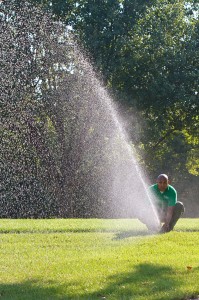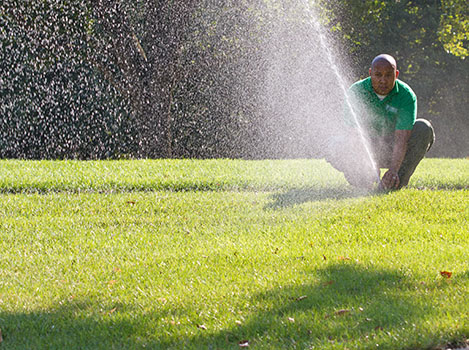
April is National Lawn Care Month, which is fitting because it puts front and center our most popular landscape feature, residential lawns.
They cover up to 40.5 million acres in the U.S. and are under assault like never before.
In the west, lawns are facing water shortages. In the east, the problem is related to water quality.
Westward: Lawns banned, a dire situation
What is a normally dry climate has been made worse by one of the most severe droughts ever recorded in the west. On top of this, the water supply infrastructure in the west has not kept up with population growth.
Some western cities and counties, faced with critical water allocation decisions, have placed lawns at the bottom of the priority list for water uses. Some even have gone so far as to ban lawns.
Las Vegas banned lawns in new developments, plus it is offering cash payments to existing homeowners to tear out their lawns and replace them with landscaping that requires no irrigation.
Los Angeles spent $1.4 million over the past five years in rebates to homeowners to replace lawns with less thirsty landscape alternatives. Many other California cities are doing the same.
In Austin, Texas, residents may have a lawn, but are banned from watering it until after dark. The fine for watering during daylight hours is $475.
While some of these programs have been put in place in response to the drought in the southwest, many are a result of a long-term trend in the more arid parts of our country to steer away from lawns and toward designs that require little or no supplemental water.
The water situation in the west is dire. Water levels in Lake Mead behind the Hoover Dam are so low they could drop below the water supply intake this year, cutting off water to many southwestern cities. Lake Mead supplies water to 20 million people in California, Arizona and Nevada.
In areas of the country where normal rainfall is typically 15 inches or less per year, it makes little sense to plant a blue grass lawn that requires one to three inches of supplemental water per week during the growing season.
Eastward: Water quality concerns
The story east of the Mississippi, where rainfall is sufficient to support a lawn without supplemental water, is bit different. The pressure on lawns in the east is due to more to concerns over water quality impairment from stormwater runoff, making it almost the reverse of the water scarcity problem in the west.
In the east, states are taking the initiative to pass laws regulating the application of turfgrass fertilizers. At least 10 states east of the Mississippi have adopted laws regulating the amount, timing and content of turfgrass fertilizer applications.
These laws are based on the assumptions lawns are bad for the environment and fertilizers are over-applied. Science shows neither assumption is accurate, though.
The science, the future
A 2013 review of the scientific evidence, by a panel of turfgrass and water quality experts commissioned by the Environmental Protection Agency, found turfgrass fertilizers were actually under applied in the Chesapeake Bay watershed.
Moreover, the study concluded to minimize runoff of nitrogen and phosphorus in rivers and streams, lawns should have a dense, healthy covering of turfgrass. Fertilizer applied in the correct amount and at the right times actually reduced pollution, the panel concluded.
So what is the future of lawns?
In the more arid parts of the country we will continue to see lawns reduced in size or eliminated in favor of landscapes that require less supplemental water. Preserving some portion of western lawns will require that we, as an industry, demonstrate we are responsible stewards of the precious water resource. Our industry will have to take the lead as the experts in efficient irrigation technology and low-water-use landscape alternatives.
In the east, lawns will persist because the climate is more conducive and the science is on our side. A healthy lawn can be a responsible way to protect water quality, which is the big issue in the east. It’s a matter of the industry getting active in educating legislators and the public about what the science says.
The future of lawns is in our hands. How are you planning to celebrate National Lawn Care Month?


